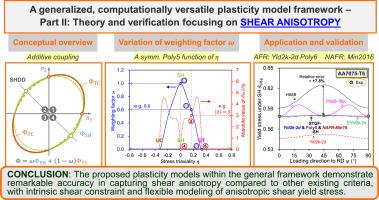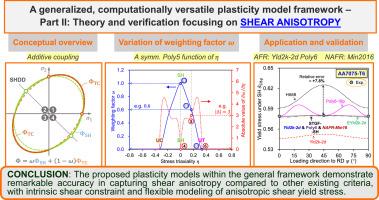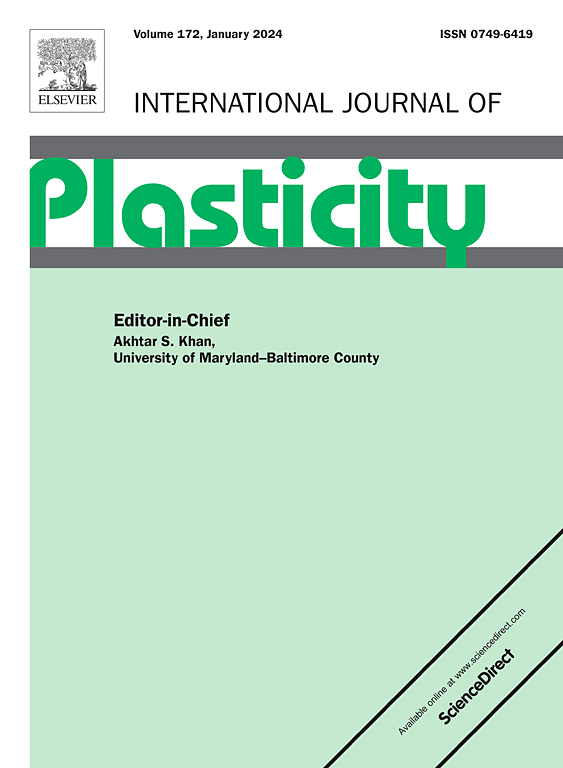A generalized, computationally versatile plasticity model framework - Part II: Theory and verification focusing on shear anisotropy
IF 9.4
1区 材料科学
Q1 ENGINEERING, MECHANICAL
引用次数: 0
Abstract
Shear-dominated deformation (SHDD) is pivotal in sheet metal forming; however, comprehensive modeling of plastic anisotropy in SHDD, specifically shear anisotropy considering both yield stress and plastic flow, has been inadequately addressed in existing literature. In this work, a generalized constitutive framework is introduced on the basis of stress triaxiality-dependent state variable to accurately emulate plastic anisotropy and the physics-based shear constraint in SHDD. The framework is capable to seamlessly integrate with existing yield criteria, preserving computational efficiency and versatility. Notably, the yield function, anisotropic parameters, and their optimization or analytical determination for the non-shear deformation state remain unaltered. When integrated with the Hill48 yield function, featuring either one or two anisotropic parameters within the generalized constitutive framework, precise characterization of yield strength and plastic flow in SHDD is achieved. The applicability of the framework extends to various anisotropic yield functions such as the widely employed Yld2k-2d and the sixth-order polynomial (Poly6) function as a class of associated flow rule-based yield functions, and one non-quadratic yield function for non-associated flow rule scenarios. Experimental validation with two engineering sheet metals, high-strength dual-phase steel DP980 and high-strength aluminum alloy AA7075-T6, was conducted. Comparative analyses with several recently proposed yield criteria, especially Poly6–18p, highlighted the efficiency of the proposed constitutive framework. Furthermore, this study explores intrinsic shear constraints, particularly the absence of through-thickness strains under in-plane shear stress. Additionally, it offers an enhanced description of plastic anisotropy in shear yield stress within the general framework, providing valuable insights into the complexities of SHDD.


通用、可计算的塑性模型框架--第二部分:以剪切各向异性为重点的理论与验证
剪切主导变形(SHDD)在金属板材成型中至关重要;然而,现有文献并未充分考虑 SHDD 中塑性各向异性的综合建模,特别是同时考虑屈服应力和塑性流动的剪切各向异性。本研究在应力三轴依赖性状态变量的基础上引入了一个广义的构成框架,以精确模拟 SHDD 中的塑性各向异性和基于物理的剪切约束。该框架能够与现有的屈服准则无缝集成,保持了计算效率和通用性。值得注意的是,屈服函数、各向异性参数以及它们在非剪切变形状态下的优化或分析确定均保持不变。当与 Hill48 屈服函数(在广义构造框架内具有一个或两个各向异性参数)集成时,可实现 SHDD 屈服强度和塑性流动的精确表征。该框架的适用性扩展到各种各向异性屈服函数,如广泛使用的 Yld2k-2d 和六阶多项式(Poly6)函数,作为一类基于关联流动规则的屈服函数,以及一种用于非关联流动规则情况的非二次屈服函数。使用两种工程金属板材(高强度双相钢 DP980 和高强度铝合金 AA7075-T6)进行了实验验证。与最近提出的几种屈服标准(尤其是 Poly6-18p)的对比分析凸显了所提出的构成框架的效率。此外,本研究还探讨了固有的剪切约束,特别是在面内剪切应力下没有穿透厚度的应变。此外,它还在一般框架内增强了对剪切屈服应力塑性各向异性的描述,为了解 SHDD 的复杂性提供了宝贵的见解。
本文章由计算机程序翻译,如有差异,请以英文原文为准。
求助全文
约1分钟内获得全文
求助全文
来源期刊

International Journal of Plasticity
工程技术-材料科学:综合
CiteScore
15.30
自引率
26.50%
发文量
256
审稿时长
46 days
期刊介绍:
International Journal of Plasticity aims to present original research encompassing all facets of plastic deformation, damage, and fracture behavior in both isotropic and anisotropic solids. This includes exploring the thermodynamics of plasticity and fracture, continuum theory, and macroscopic as well as microscopic phenomena.
Topics of interest span the plastic behavior of single crystals and polycrystalline metals, ceramics, rocks, soils, composites, nanocrystalline and microelectronics materials, shape memory alloys, ferroelectric ceramics, thin films, and polymers. Additionally, the journal covers plasticity aspects of failure and fracture mechanics. Contributions involving significant experimental, numerical, or theoretical advancements that enhance the understanding of the plastic behavior of solids are particularly valued. Papers addressing the modeling of finite nonlinear elastic deformation, bearing similarities to the modeling of plastic deformation, are also welcomed.
 求助内容:
求助内容: 应助结果提醒方式:
应助结果提醒方式:


